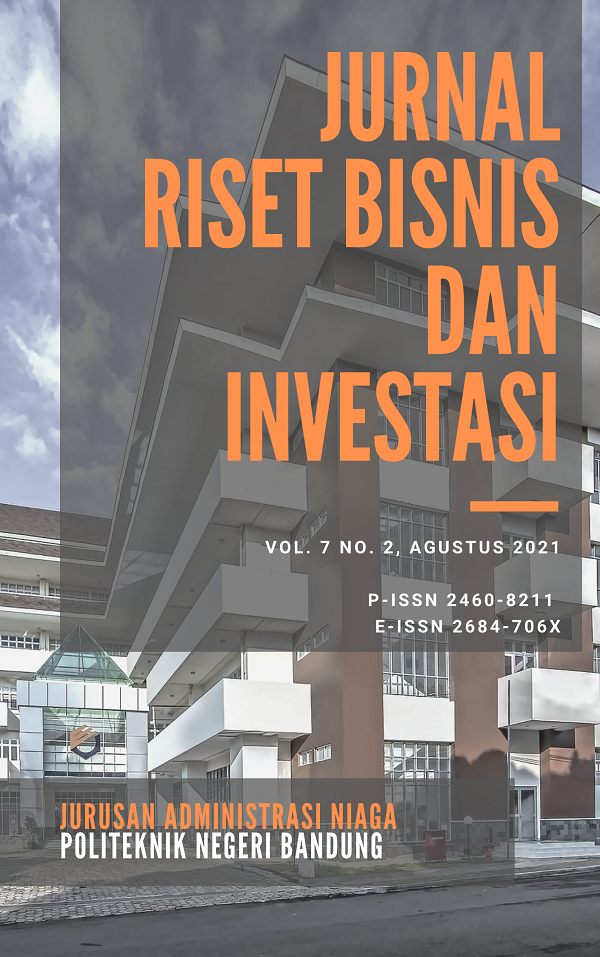Pengaruh Rasio Hutang Terhadap Profitabilitas (Studi Pada Perusahaan Properti & Real Estate Terdaftar di Bursa Efek Indonesia Periode 2020)
Main Article Content
Abstract
The characteristics of the property as a product that does not depreciate raises speculation that property as a product will not end up as consumption, but an investment. However, sales that occur are not automatically recognized in the recording of financial statements after the application of PSAK 72. The application of PSAK 72 will at least affect the profits and debt levels of property companies because sales that have not been recognized will be included as current liabilities. In this study, the GPM (gross profit margin) ratio is used to determine the profit margin, ROA (return on assets) to determine the return on investment, and DR (debt ratio) to determine the amount of debt to total funding. The research methods used in this study include descriptive analysis, regression analysis, coefficient of determination analysis, and hypothesis testing. The results showed that debt ratio has a negative effect on profitability.
Downloads
Article Details

This work is licensed under a Creative Commons Attribution-ShareAlike 4.0 International License.
Authors who publish with this journal agree to the following terms:
a. Authors retain copyright and grant the journal right of first publication, with the work after publication simultaneously licensed under a Creative Commons Attribution License that allows others to share the work with an acknowledgment of the work's authorship and initial publication in this journal.
b. Authors are able to enter into separate, additional contractual arrangements for the non-exclusive distribution of the journal's published version of the work (e.g., post it to an institutional repository or publish it in a book), with an acknowledgment of its initial publication in this journal.
c. Authors are permitted and encouraged to post their work online (e.g., in institutional repositories or on their website) prior to and during the submission process, as it can lead to productive exchanges, as well as earlier and greater citation of published work (See The Effect of Open Access).
References
Departemen Statistik BI. (2020b). Survei Harga Properti Residensial. https://www.bi.go.id/id/publikasi/laporan/Documents/SHPR-Triwulan-IV-2020.pdf
Dwiantari, R. A., Gede, L., & Artini, S. (2021). The Effect of Liquidity , Leverage , and Profitability on Financial Distress ( Case Study of Property and Real Estate Companies on the IDX 2017-2019 ). American Journal of Humanities and Social Sciences Research (AJHSSR), 5(1), 367–373. www.ajhssr.com
Fauzan, M. R., & Mukaram, M. (2018). Pengaruh Struktur Modal Terhadap Profitabilitas (Studi Pada Perusahaan Pertambangan Yang Terdaftar di Bursa Efek Indonesia Periode 2011-2015). Jurnal Riset Bisnis Dan Investasi, 3(3), 89. https://doi.org/10.35697/jrbi.v3i3.948
Gursida, H., & Harmon. (2017). Metode Penelitian Bisnis dan Keuangan. Paspi.
Hery. (2016). Analisis Laporan Keuangan. Grasindo.
Ismail, F. (2018). Statistika Untuk Penelitian Pendidikan dan Ilmu-Ilmu Sosial. Kencana.
Jusmansyah, M. (2020). Analisis Pengaruh Manajemen Modal Kerja dan Leverage Terhadap Gross Profit Margin. Jurnal Akuntansi Dan Keuangan, 9(1), 32–48.
Kimmel, P. D., Weygand, J. J., & Kieso, D. E. (2016). Financial Accounting: Tools for Business Decision Making 8th. John Wiley & Sons.
Liana, T. M. M. (2020). Analisis Faktor-Faktor yang Mempengaruhi Nilai Perusahaan dengan ROA Sebagai Variabel Intervening (Studi Pada Perusahaan Manufaktur Food and Beverages yang Terdaftar di BEI Tahun 2015-2017). Jurnal Ilmiah Maksitek, 5(3), 140–149.
Lind, D. A., Marchal, W. G., & Wathen, S. A. (2008). Statistical Techniques in Business and Economics with Global Data Sets (13th ed.). Salemba Empat.
Mijić, K., & Jakšić, D. (2017). Indebtedness of Enterprises and Profitability Improvement. Strategic Management, 22(2), 36–40.
Nopitasari, H., Tiorida, E., & Sarah, I. S. (2018). Pengaruh Financial Leverage Terhadap Kinerja Keuangan (Studi Pada Perusahaan Properti dan Real Estate yang Terdaftar di Bursa Efek Indonesia Periode 2011-2015). Jurnal Riset Bisnis Dan Investasi, 3(3), 45. https://doi.org/10.35697/jrbi.v3i3.944
Nugroho, S. (2008). Dasar-dasar Metode Statistika. Grasindo.
Ophelia, A., Min, S., Aliou, D. M., Farhana, A., George, N., Justice, G., & Philip, A. S. (2021). The impact of Debt Financing on Performance of Small and Medium Enterprises in Ghana. International Journal of Advanced Engineering Research and Science, 8(7), 193–201. https://doi.org/10.22161/ijaers.87.23
Prihadi, T. (2019). Analisis Laporan Keuangan Konsep dan Aplikasi. Gramedia.
Puspitasari, R., Yanfitri, & Prastowo, N. J. (2020). Transmisi Kebijakan Moneter di Indonesia Melalui Jalur Balance Sheet: Dampak Kondisi Domestik dan Eksternal. In F. Mochtar, Sahminan, & A. S. Budiman (Eds.), Transmisi Kebijakan Moneter di Indonesia Menuju Era Ekonomi Digital (pp. 91–132). Bank Indonesia. https://www.bi.go.id/id/publikasi/kajian/Documents/Transmisi-Kebijakan-Moneter-di-Indonesia-Menuju-Era-Ekonomi-Digital.pdf
Sudana, I. M. (2019). Manajemen Keuangan Teori dan Praktik. Airlangga University Press.
Sulindawati, N. L., Yuniarti, G. A., & Purnamawati, I. G. A. (2017). Manajemen Keuangan: Sebagai Dasar Pengambilan Keputusan Bisnis. Rajawali Press.
Taillard, M. (2013). Corporate Finance for Dummies. John Wiley & Sons.
Yuri, R., Fatonah, S., & Meilisa, R. (2021). Pengaruh Current Ratio (CR) dan Debt to Equity Ratio (DER) Terhadap Gross Profit Margin (GPM) (Studi Kasus pada Perusahaan Manufaktur SUbsektor Farmasi yang Terdaftar Di Bursa Efek Indonesia). Jurnal Bina Bangsa Ekonomika, 14(1), 172–181.

